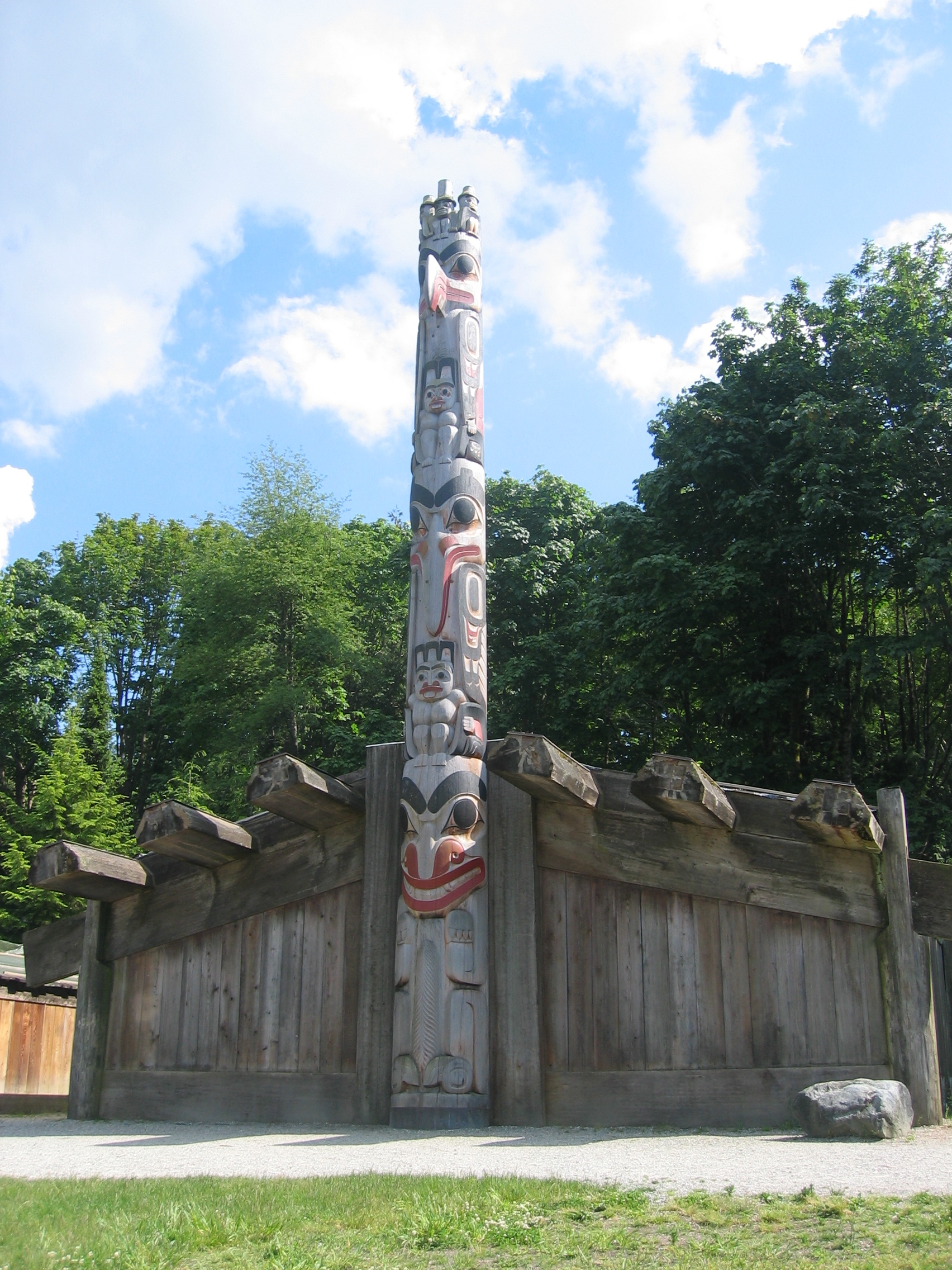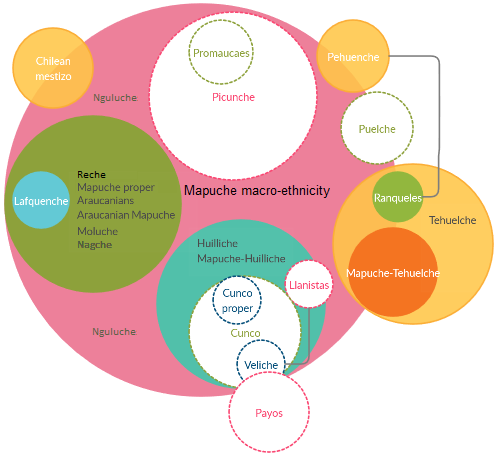|
Maloca
A maloca is an ancestral long house built by Indigenous people of the Amazon, notably in Colombia and Brazil. Each community has a single maloca with its distinct characteristics. Several families with patrilineal or matrilineal relations live together in a maloca, distributed around the long house in different compartments. In general, the chief of the local descent group lives in the compartment nearest to the back wall of the long house. As well, each family has its own hearth. During festivals and in formal ceremonies, which involve dances for males, the long house space is rearranged; the centre of the long house is the most important area where the dance takes place. Each maloca has two entrances, one for men and one for women. Married men and women sleep together, and unmarried men and women sleep separately. A maloca is traditionally surrounded by two gardens: the inner called the kitchen gardens (growing plants such as bananas, papaya, mango, and pineapple) and the ... [...More Info...] [...Related Items...] OR: [Wikipedia] [Google] [Baidu] |
Longhouse
A longhouse or long house is a type of long, proportionately narrow, single-room building for communal dwelling. It has been built in various parts of the world including Asia, Europe, and North America. Many were built from lumber, timber and often represent the earliest form of permanent structure in many cultures. Types include the Neolithic long house of Europe, the Norman Medieval Longhouses that evolved in Western Britain (''Tŷ Hir'') and Northern France (''Longère''), and the Longhouses of the indigenous peoples of North America, various types of longhouse built by different cultures among the indigenous peoples of the Americas. Europe The Neolithic long house type was introduced with the first farmers of Central Europe, Central and Western Europe around 5000 BCE, 7,000 years ago. These were farming settlements built in groups of six to twelve longhouses; they were home to large extended families and kin. The Germanic cattle-farmer longhouses emerged along the southw ... [...More Info...] [...Related Items...] OR: [Wikipedia] [Google] [Baidu] |
Amazon Basin
The Amazon basin is the part of South America drained by the Amazon River and its tributary, tributaries. The Amazon drainage basin covers an area of about , or about 35.5 percent of the South American continent. It is located in the countries of Bolivia, Brazil, Colombia, Ecuador, Guyana, Peru, Suriname, and Venezuela, as well as the territory of French Guiana. Most of the basin is covered by the Amazon rainforest, also known as Amazon rainforest, Amazonia. With a area of dense tropical forest, it is the largest rainforest in the world. Geography The Amazon River begins in the Andes, Andes Mountains at the west of the basin with its main tributary the Marañón River and Apurímac River, Apurimac River in Peru. The highest point in the Drainage divide, watershed of the Amazon is the second biggest peak of Yerupajá at . The Amazon River Basin occupies the entire central and eastern area of South America, lying to the east of the Andes mountain range and extending from th ... [...More Info...] [...Related Items...] OR: [Wikipedia] [Google] [Baidu] |
Patrilineality
Patrilineality, also known as the male line, the spear side or agnatic kinship, is a common kinship system in which an individual's family membership derives from and is recorded through their father's lineage. It generally involves the inheritance of property, rights, names, or titles by persons related through male kin. This is sometimes distinguished from cognate kinship, through the mother's lineage, also called the spindle side or the distaff side. A patriline ("father line") is a person's father, and additional ancestors, as traced only through males. In the Bible In the Bible, family and tribal membership appears to be transmitted through the father. For example, a person is considered to be a priest or Levite, if his father is a priest or Levite, and the members of all the Twelve Tribes are called Israelites because their father is Israel (Jacob). In the first lines of the New Testament, the descent of Jesus Christ is counted through the male lineage from Abraham throug ... [...More Info...] [...Related Items...] OR: [Wikipedia] [Google] [Baidu] |
Matrilineal
Matrilineality, at times called matriliny, is the tracing of kinship through the female line. It may also correlate with a social system in which people identify with their matriline, their mother's lineage, and which can involve the inheritance of property and titles. A matriline is a line of descent from a female ancestor to a descendant of either gender in which the individuals in all intervening generations are mothers. In a matrilineal descent system, individuals belong to the same descent group as their mothers. This is in contrast to the currently more popular pattern of patrilineal descent from which a family name is usually derived. The matriline of historical nobility was also called their enatic or uterine ancestry, corresponding to the patrilineal or "agnatic" ancestry. Early human kinship Scholars disagree on the nature of early human, that is, Homo sapiens, kinship. In the late 19th century, most scholars believed, influenced by Lewis H. Morgan's book ' ... [...More Info...] [...Related Items...] OR: [Wikipedia] [Google] [Baidu] |
Tribal Chief
A tribal chief, chieftain, or headman is a leader of a tribe, tribal society or chiefdom. Tribal societies There is no definition for "tribe". The concept of tribe is a broadly applied concept, based on tribal concepts of societies of western Afroeurasia. Tribal societies are sometimes categorized as an intermediate stage between the band society of the Paleolithic stage and civilization with centralized, super-regional government based in Cities of the Ancient Near East, cities. Anthropologist Elman Service distinguishes two stages of tribal societies: simple societies organized by limited instances of social rank and prestige, and more stratified society, stratified societies led by chieftains or tribal kings (chiefdoms). Stratified tribal societies led by tribal kings are thought to have flourished from the Neolithic stage into the Iron Age, albeit in competition with Urban area, urban civilisations and empires beginning in the Bronze Age. In the case of tribal societies ... [...More Info...] [...Related Items...] OR: [Wikipedia] [Google] [Baidu] |
Malón
''Malón'' (from the Mapuche language, Mapudungun ''maleu,'' to inflict damage to the enemy) is the name given to plunder raids carried out by Mapuche warriors, who rode horses into Spanish, Chilean and Argentine territories from the 17th to the 19th centuries, as well as to their attacks on rival Mapuche factions. Historian Juan Ignacio Molina said the Mapuche considered the malón to be a means of obtaining justice: Leaders such as Lientur used the malón against European colonists: it consisted of a fast surprise attack by a number of mounted Mapuche warriors against the white (''huinca'') populations, hacienda, ranches, settlements and fortifications in Chile and Argentina, with the aim of obtaining horses, cattle, provisions, and captives, often young women. The rapid attack without formal order did not give the targets time to organise any defence, and it left behind a devastated population unable to retaliate or pursue. In Chile, the Spaniards responded with a system ... [...More Info...] [...Related Items...] OR: [Wikipedia] [Google] [Baidu] |
Mapuche
The Mapuche ( , ) also known as Araucanians are a group of Indigenous peoples of the Americas, Indigenous inhabitants of south-central Chile and southwestern Argentina, including parts of Patagonia. The collective term refers to a wide-ranging ethnicity composed of various groups who share a common social, religious, and economic structure, as well as a common linguistic heritage as Mapudungun speakers. Their homelands once extended from Choapa River, Choapa Valley to the Chiloé Archipelago and later spread eastward to Puelmapu, a land comprising part of the Pampas, Argentine pampa and Patagonia. Today the collective group makes up over 80% of the Indigenous peoples in Chile and about 9% of the total Chilean population. The Mapuche are concentrated in the Araucanía (historic region), Araucanía region. Many have migrated from rural areas to the cities of Santiago and Buenos Aires for economic opportunities, more than 92% of the Mapuches are from Chile. The Mapuche traditional e ... [...More Info...] [...Related Items...] OR: [Wikipedia] [Google] [Baidu] |
Jesuit Missions Of Chiquitos
The Jesuit Missions of Chiquitos are located in the Santa Cruz Department (Bolivia), Santa Cruz Departments of Bolivia, department in eastern Bolivia. Six of these former missions (all now secular municipalities) collectively were designated as a UNESCO World Heritage Site in 1990. Distinguished by a unique fusion of Culture of Europe, European and Amerindian cultural influences, the missions were founded as Jesuit Reductions, reductions or ''reducciones de indios'' by Jesuits in the 17th and 18th centuries to convert local tribes to Christianity. The interior region bordering Spanish and Portugal, Portuguese territories in South America was largely unexplored at the end of the 17th century. Dispatched by the Spanish Crown, Jesuits explored and founded eleven settlements in 76 years in the remote Chiquitania – then known as Chiquitania, Chiquitos – on the frontier of Spanish America. They built churches (''templos'') in a unique and distinct style that combined elements of nat ... [...More Info...] [...Related Items...] OR: [Wikipedia] [Google] [Baidu] |
Huts
A hut is a small dwelling, which may be constructed of various local materials. Huts are a type of vernacular architecture because they are built of readily available materials such as wood, snow, stone, grass, palm leaves, branches, clay, hides, fabric, or mud using techniques passed down through the generations. The construction of a hut is generally less complex than that of a house (durable, well-built dwelling) but more so than that of a shelter (place of refuge or safety) such as a tent and is used as temporary or seasonal shelter or as a permanent dwelling in some indigenous societies.Oxford English Dictionary Second Edition on CD-ROM (v. 4.0) © Oxford University Press 2009 Huts exist in practically all nomadic cultures. Some huts are transportable and can stand most conditions of weather. Word The term is often employed by people who consider non-western style homes in tropical and sub-tropical areas to be crude or primitive, but often the designs are based on tra ... [...More Info...] [...Related Items...] OR: [Wikipedia] [Google] [Baidu] |
Indigenous Culture Of The Amazon
Indigenous may refer to: *Indigenous peoples *Indigenous (ecology), presence in a region as the result of only natural processes, with no human intervention *Indigenous (band), an American blues-rock band *Indigenous (horse), a Hong Kong racehorse * ''Indigenous'' (film), Australian, 2016 See also *Indigenous Australians *Indigenous language *Indigenous peoples in Canada *Indigenous religion *Missing and Murdered Indigenous Women Missing and Murdered Indigenous Women are instances of violence against Indigenous women in Canada and the United States, notably those in the First Nations in Canada and Native American communities, but also amongst other Indigenous peoples s ... * Native (other) * * {{disambiguation ... [...More Info...] [...Related Items...] OR: [Wikipedia] [Google] [Baidu] |






